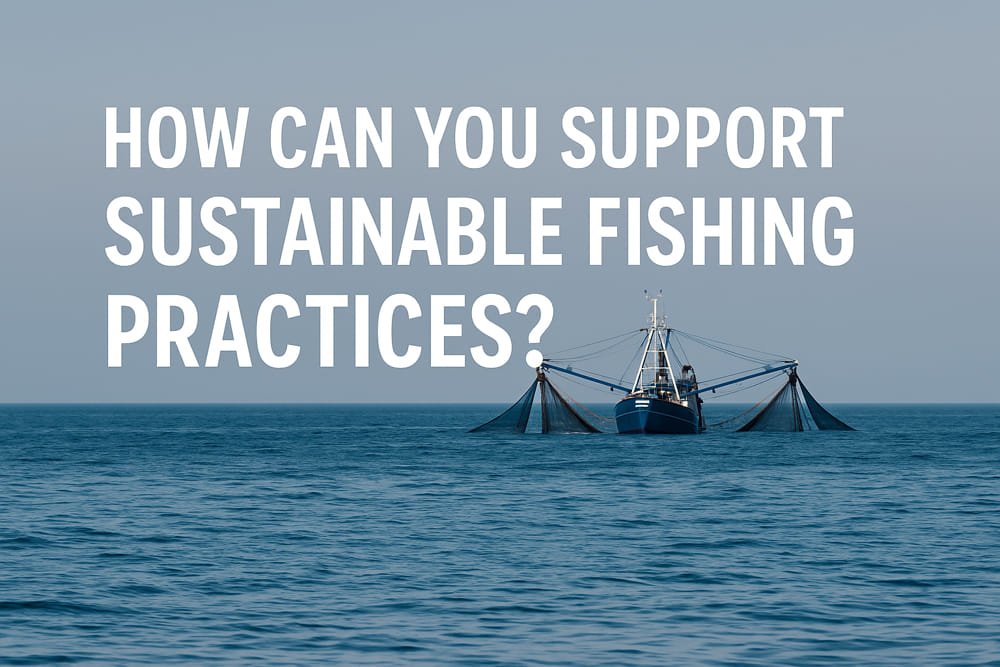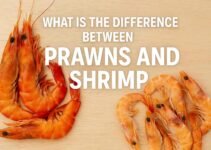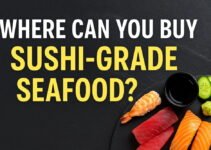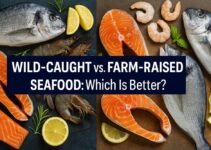Sustainable fishing is the only way to preserve global fish populations while maintaining a stable food supply for future generations. According to the Food and Agriculture Organization (FAO), over 34% of the world’s fish stocks are overfished, directly threatening marine biodiversity and food security. Without immediate action, this number will continue to rise, leading to irreversible ecosystem damage.
Supporting sustainable fishing practices is not limited to governments and large organizations. Every consumer decision you make—whether purchasing seafood at a local market or dining at a restaurant—plays a measurable role in protecting marine life. This guide provides precise, actionable strategies to help you support sustainable fishing, whether through informed purchasing choices, advocating for effective regulations, or encouraging businesses to prioritize sustainability.
By the end of this article, you will understand exactly how to identify sustainable seafood, recognize impactful policy changes, and apply practical steps to contribute directly to marine conservation efforts.
Contents
- 1 What Are the Core Principles of Sustainable Fishing?
- 2 How Can You Identify and Choose Sustainable Seafood Products?
- 3 How Can Restaurants and Retailers Promote Sustainable Fishing?
- 4 How Do Government Policies Impact Sustainable Fishing Efforts?
- 5 How Can Fishing Communities Transition Toward Sustainable Practices?
- 6 How Does Technology Improve Sustainable Fishing Practices?
- 7 What Are Simple Actions You Can Take Today to Support Sustainable Fishing?
What Are the Core Principles of Sustainable Fishing?
Sustainable fishing follows three core principles: preserving fish populations, protecting marine habitats, and supporting local fishing communities. These principles ensure long-term ecological balance and economic viability for those who depend on the fishing industry.
- Preserving Fish Populations:
Sustainable fishing maintains fish populations at healthy reproductive levels. The FAO sets biological reference points to prevent fishery collapse. For example, the North Pacific halibut stock is managed through science-based quotas, keeping population levels within safe biological limits. - Protecting Marine Habitats:
Fishing practices must avoid damaging fragile habitats like coral reefs, seagrass beds, and mangroves. Destructive methods such as bottom trawling remove up to 98% of benthic life in a single pass, causing decades-long damage. Sustainable practices include the use of selective gear like pole-and-line or handline methods that minimize habitat disruption. - Supporting Local Communities:
Sustainable fishing empowers small-scale fishing communities by promoting fair trade practices and equitable profit distribution. Certified programs like Fair Trade USA have directly increased incomes for over 10,000 small-scale fishermen worldwide by ensuring sustainable catch practices and fair market access.
How Can You Identify and Choose Sustainable Seafood Products?
You can identify sustainable seafood products by looking for globally recognized certifications and understanding which species are harvested responsibly.
Which Seafood Labels and Certifications Guarantee Sustainability?
There are four major certifications ensuring seafood sustainability:
- Marine Stewardship Council (MSC): Focuses on wild-caught seafood sustainability.
- Aquaculture Stewardship Council (ASC): Certifies responsible fish farming operations.
- Dolphin Safe Label: Ensures tuna fishing practices do not harm dolphins.
- Fair Trade Certified Seafood: Supports environmental protection and improves working conditions for fishing communities.
Always check product packaging for these certifications. The MSC blue label, for instance, is present on over 20,000 seafood products globally, ensuring adherence to strict environmental and sustainability standards.
What Are the Most Sustainable Types of Seafood to Eat?
According to the Monterey Bay Aquarium’s Seafood Watch, the five most sustainable seafood options are:
- Mussels
- Oysters
- Alaskan salmon
- Pacific sardines
- Arctic char
These species reproduce quickly, have low environmental impact, and are often farmed or harvested using responsible methods.
How Can You Avoid Purchasing Overfished or Endangered Species?
Check updated seafood watch lists before purchasing. Avoid high-risk species such as bluefin tuna, Chilean sea bass, and Atlantic cod, which are currently classified as overfished. Use resources like the Marine Conservation Society’s Good Fish Guide or the Seafood Watch app to verify which species are sustainable before buying.
How Can Restaurants and Retailers Promote Sustainable Fishing?
Restaurants and retailers promote sustainable fishing by sourcing certified products, training staff to educate consumers, and publicly committing to sustainability goals.
What Questions Should You Ask When Ordering Seafood at Restaurants?
Ask these three direct questions to ensure the seafood you’re served is sustainable:
- Is this seafood MSC or ASC certified?
- Is the fish wild-caught or farm-raised sustainably?
- Can you tell me the source or fishery of this product?
Restaurants that actively support sustainability will provide this information transparently.
How Do Retailers Ensure Their Seafood Supply Chains Are Sustainable?
Retailers implement sustainability by partnering with verified suppliers and conducting regular audits. For instance, Walmart pledged to source 100% of its fresh and frozen seafood from sustainable fisheries or responsible aquaculture by 2025, influencing over $2 billion in seafood sales annually toward sustainable options.
Should Businesses Partner with Sustainability Certification Bodies?
Yes. Partnerships with certification bodies increase consumer trust and market competitiveness. Companies like Whole Foods and Costco have already integrated MSC and ASC certifications into their seafood supply chains, boosting both sales and brand reputation.
How Do Government Policies Impact Sustainable Fishing Efforts?
Government policies directly influence the health of marine ecosystems by regulating fishing practices, enforcing conservation measures, and promoting international cooperation.
What Are the Most Effective Fishing Regulations Implemented Globally?
There are five primary regulatory mechanisms proven effective in managing fisheries sustainably:
- Total Allowable Catch (TAC) Limits: Controls the maximum volume of specific species that can be harvested annually. For example, the European Union’s Common Fisheries Policy enforces TAC limits across member states.
- Individual Transferable Quotas (ITQs): Assigns fishers a specific share of the total catch limit, encouraging responsible harvesting. New Zealand’s ITQ system has successfully maintained sustainable fisheries since 1986.
- Fishing Gear Restrictions: Prohibits harmful equipment like bottom trawls or drift nets in sensitive habitats.
- Seasonal Closures: Temporarily halts fishing during breeding seasons to allow stock replenishment.
- Catch Reporting and Monitoring: Requires transparent documentation of catches, reducing illegal, unreported, and unregulated (IUU) fishing activities.
How Do Marine Protected Areas (MPAs) Help Sustain Fish Populations?
Marine Protected Areas safeguard critical habitats and create safe breeding grounds. According to the United Nations, there are over 18,000 MPAs globally, covering approximately 8% of the world’s oceans. These areas lead to:
- 35% higher fish biomass within protected zones.
- 21% greater species diversity compared to non-protected areas.
Successful examples include the Great Barrier Reef Marine Park in Australia and the Papahānaumokuākea Marine National Monument in the U.S., both significantly improving regional fish populations and ecosystem health.
Why Is International Cooperation Critical for Managing Shared Fisheries?
Fish populations migrate across national boundaries; therefore, sustainable management requires international agreements. Organizations like the Regional Fisheries Management Organizations (RFMOs) regulate fisheries in international waters. A notable success is the International Commission for the Conservation of Atlantic Tunas (ICCAT), which implements strict quotas for bluefin tuna recovery. Without such cooperation, individual nations often overexploit migratory species, undermining global conservation efforts.
How Can Fishing Communities Transition Toward Sustainable Practices?
Fishing communities transition to sustainable practices through financial support, education, and access to sustainable technologies.
What Are the Economic Challenges of Adopting Sustainable Methods?
The transition requires upfront investments, including purchasing selective gear, reducing fishing days, and undergoing sustainability training. According to the World Bank, over 60% of small-scale fishers struggle to afford these changes without financial assistance. Challenges include:
- Reduced short-term income due to lower fishing quotas.
- Limited market access for certified sustainable products.
- High costs for eco-friendly fishing technologies.
How Can NGOs and Governments Support Fishermen in This Transition?
Support is provided through three critical approaches:
- Subsidies and Grants: Governments offer financial incentives to offset the cost of sustainable gear and practices.
- Education and Training Programs: NGOs like the World Wildlife Fund (WWF) provide workshops on responsible fishing techniques and resource management.
- Market Access Support: Initiatives like the Fair Trade USA program help connect small-scale fishers with premium buyers willing to pay higher prices for sustainably caught seafood.
Are There Examples of Successful Community-Led Sustainability Programs?
Yes, the Locally Managed Marine Area (LMMA) Network in the Pacific Islands demonstrates how community-led programs restore depleted fish stocks. In Fiji, over 250 communities participate in LMMA programs, leading to a 200% increase in fish abundance within protected zones. These models prove that community-driven efforts, backed by proper policy support, deliver measurable environmental and economic results.
How Does Technology Improve Sustainable Fishing Practices?
Advanced technologies enhance sustainable fishing by improving monitoring, reducing bycatch, and increasing supply chain transparency.
What Is the Role of Electronic Monitoring and GPS in Reducing Bycatch?
Electronic monitoring systems use cameras and sensors on fishing vessels to ensure compliance with sustainable practices. According to the Environmental Defense Fund, vessels equipped with such systems achieve a 30% reduction in bycatch incidents. GPS tracking also prevents illegal fishing in restricted zones and helps fishers avoid overfished areas, reducing unintended environmental harm.
How Do Artificial Reefs and Hatcheries Contribute to Sustainability?
Artificial reefs provide habitats that accelerate the recovery of fish populations. For instance, the Osborne Reef project in Florida, although initially controversial, led to new developments in artificial reef design that now successfully support marine biodiversity. Fish hatcheries supplement wild populations by breeding and releasing juvenile fish, particularly for species like salmon and trout, improving their survival rates and reducing fishing pressure on wild stocks.
Can Blockchain Improve Traceability in the Seafood Supply Chain?
Blockchain technology offers secure, transparent tracking of seafood products from catch to consumer. Companies like Provenance and IBM Food Trust already implement blockchain solutions to ensure product authenticity. This technology prevents mislabeling, combats illegal fishing, and assures buyers that their seafood meets sustainability standards. According to IBM, blockchain solutions in food supply chains can reduce fraud-related losses by up to 50%.
What Are Simple Actions You Can Take Today to Support Sustainable Fishing?
Supporting sustainable fishing starts with immediate, conscious actions that influence supply chains, consumer markets, and policymaking. Every purchase, conversation, and advocacy effort directly contributes to marine conservation.
Buy Certified Sustainable Seafood Products
Choose products labeled with certifications such as MSC, ASC, and Fair Trade Certified. These programs guarantee that seafood was sourced following strict environmental and social responsibility standards. According to MSC, over 20,000 seafood products worldwide now carry their certification, making it easier than ever to make responsible choices.
Support Local Fishing Communities That Follow Sustainable Practices
Purchasing directly from small-scale fisheries that implement sustainable methods helps preserve both local economies and marine ecosystems. In regions like Southeast Asia, community-supported fisheries (CSFs) have seen a 25% rise in consumer participation over the past five years, demonstrating growing market demand for responsibly sourced products.
Advocate for Stronger Fishing Regulations and Marine Protection Policies
Engage with policymakers by supporting legislation that enforces sustainable fishing limits, expands Marine Protected Areas (MPAs), and combats illegal fishing practices. Public advocacy has already contributed to global successes, such as the expansion of the Papahānaumokuākea Marine National Monument, which now protects 1.5 million square kilometers of critical ocean habitat.
Reduce Personal Seafood Waste to Lower Overall Fishing Pressure
According to the FAO, up to 35% of seafood is wasted globally, placing unnecessary strain on fish populations. Plan meals carefully, store seafood properly, and repurpose leftovers to minimize waste. Reducing demand helps stabilize overexploited fisheries.
Share Knowledge and Encourage Others to Make Sustainable Choices
Inform family, friends, and social networks about the importance of sustainable seafood. Recommend tools like the Seafood Watch App or the Good Fish Guide to help others make informed purchasing decisions. Social influence plays a powerful role in shaping market trends and encouraging responsible consumption habits.
By integrating these simple yet impactful actions into your lifestyle, you become a direct contributor to the preservation of marine life. Sustainable fishing is not an abstract concept reserved for policymakers or environmental groups—it is a movement driven by informed consumers like you. Each responsible choice ripples through supply chains, strengthens coastal communities, and safeguards the oceans for future generations.



